|
The Life and Mystery of Everett Ruess
by Dana Thomas
In 1934, twenty-year old Everett Ruess, trailing two burros walked into the red rock canyons surrounding Escalante, Utah and disappeared from the face of the earth.
The desert Southwest has attracted individualists, certified characters and those searching for a better life or a deeper understanding of themselves. The open deserts, high plateaus, deep twisted canyons and wide-open skies have served as a palette for those searching for natural beauty, scientific discovery, adventure or internal peace.
In 1869, John Wesley Powell descended the Green and Colorado Rivers with a small crew in wooden dories. He opened the eyes of the world to the natural beauty of the sandstone canyons and the power of the western rivers.
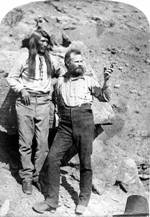
John Wesley Powell (right)
The pioneering environmentalist, Edward Abbey used his prose to paint beautiful pictures of the southwest, championed protection of the desert and eventually argued for social upheaval to reverse the exploitation of desert southwest.
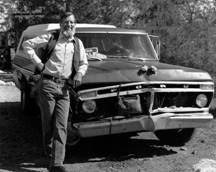
Edward Abbey
Today, Craig Childs continues the legacy, walking across the mesas and through the canyons, studying and writing about, the wildlife, the hydrology and the ancient societies who struggled to live in the arid country.
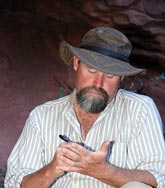
Craig Childs
Powell, Abbey and Childs were lucky, spending years exploring the southwest, gathering experience, developing their perspective and allowing their writing to mature as they battled to describe the beauty, mystery and complexity of the dry terrain. In contrast, the fourth member of my quartet of southwest bards, Everett Ruess arrived in the desert as a boy, burned brightly, disappeared before fully developing his voice and left behind an impenetrable mystery.
In 1930, at the age of sixteen Everett began four and a half years of wandering in California and the four-corner region of the southwest. His rustic woodcuts, passionate letters, journal entries and poetry serve to provide an incomplete look into his mind and motivations. His disappearance in 1934 continues to intrigue those who believe that all mysteries must be solved.

Everett Ruess and Curly
Everett Ruess was born in 1914 to an accomplished family. His father, Christopher, graduated summa cum laude from Harvard Divinity School in three years, served as a Unitarian minister and was a member of the probation departments of Alameda and Los Angeles Counties. Stella, his mother studied art at USC, block printing at Columbia University, taught art in Alhambra and encouraged Everett’s gift for art and writing while nurturing his independence. His older brother Waldo, spent 23 years traveling, visiting over 100 countries, living in ten and marrying an Andalucian woman before settling down in Santa Barbara.
The family moved frequently about the United States during Everett’s early life before settling in Southern California. This nomad existence allowed young Everett to attend art school in both New York and Chicago.
Christopher and Stella Ruess raised two sons whose wanderlust and pursuit of meaningful lives, fell outside the accepted norms of the 1930’s. At times, Christopher’s letters to his son expressed his desire that Everett follow a more conventional path, but Everett fought this influence, choosing his own road. Stella was happy to have Everett pursue the life of an artist. She raised her sons to write poetry and articles that she published in a family booklet named the Ruess Quartette. Stella’s influence on Everett is evident in the fact that his artistic interests; lyrical prose, poetry, painting and block printing were similar to her own.
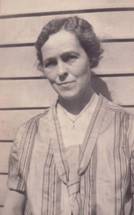
Stella Ruess
Travels
1930
Everett Ruess turned sixteen in 1930 at the beginning of the depression, a time when money was scarce and his family was struggling to make ends meet. In the summer before his last year of high school, Everett embarked on a trip that was not unusual for any Southern California boy coming of age before criminals haunted the highways and hitchhiking became a dangerous mode of transportation.
In June, Everett left home and hitchhiked up the coast of California with the goal of seeing Monterey, Carmel and Big Sur before traveling east to Yosemite. In his letters home, we see that Everett was more then a boy exploring new freedom and trying on his coming manhood. His letters speak of artistic interests and not of worldly pursuits to which a newly liberated sixteen year old might gravitate. After arriving in Carmel, he writes, not of girls or parties; but rather that, “I had a jolly time yesterday tramping up and down the beach. Then I sat in a throne-like place on a rock until a breaker came and splashed over me.”
In this same letter, we see a side of Everett that contradicts those who classify him as an anti-social teenager, ill at ease with people and uncomfortable in the world. He writes almost nonchalantly that, “I went to Edward Weston’s studio and made friends with him.” The matter of fact way he speaks of introducing himself to one of the most famous photographers of his era tells us that this is not an average sixteen year old. He not only resolutely walked up to Weston’s front door; he spent time with his family and explored the beaches with Weston’s sons.
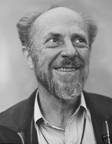
Edward Weston
Everett painted while in Monterey, creating watercolors that became wood blocks, which were than offered up for sale to finance his travels. During most of his time in Central California, Everett explored, hiking Carmel’s Seventeen-Mile Drive and taking an extended trip to visit Big Sur. During this first summer away from home, Everett wrote many letters, but they were of a chatty variety, describing his activities and his obsession with money, both how to earn it and how he was spending it. His father was sending him checks by mail and Everett was selling a few wood block prints, but many of his letters attest to the tension he felt between his disdain for money and his need to support his travels. On August 1, he wrote to his family, “I have earned $14 this week, $12 of it in three days. I don’t intend to spend any more time on money this summer, but will spend the rest of it painting and traveling.” In the letters Everett wrote in 1930, we see very little of the lyrical prose or his abandonment of a conventional lifestyle that he would write about during later travels. Instead, we see a young man on an adventure, concerned with reporting the details of a summer vacation.
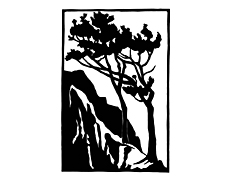
Sentinels by Everett Ruess
After a few days in Big Sur, Everett returned to Carmel, spent an afternoon watching Weston photograph kelp and then in early August left the coast for Yosemite. In Yosemite, he hiked and explored, visited the Valley Floor and Lake Tenaya, rolled a boulder off a cliff, read and visited the Village and Camp Curry. At the end of one letter home, he complains of the weight of his backpack and makes the observation; “I would like to have a burro next time I start a hike of this kind. They cost $1.50 a day and you can buy them for $15 or less.”
In the autumn of 1930, Everett returned to Los Angeles and high school, graduating from Hollywood High in January 1931. We know from later letters that his father, Christopher, wanted Everett to attend college. Instead, Everett began preparations to spend the spring and summer exploring the deserts of Arizona.
1931
On February 13, 1931 from a letter to his high school friend Bill Jacobs, Everett tells us that he is in Kayenta, Arizona at the edge of Monument Valley. He describes a long and eventful trip, hitchhiking across the California and Arizona deserts through Flagstaff and finally onto the Navajo Reservation where he buys a burro to carry his gear.
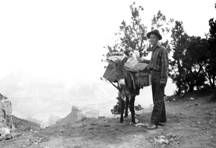
Everett Ruess
The Monument Valley of the 1930’s was a remote place. The closest city was Flagstaff, 250 miles distant and the hoards of tourist buses that haunt the valley today were decades away. The Navajo’s primary contacts with the outside world were the Anglo traders who ran government approved trading posts. In Kayenta, the trading post was manned by John Weatherill, who offered Everett a place to stay during his first days on the reservation. John was one of four brothers who had discovered the cliff ruins at Mesa Verde and his stories would fuel Everett’s desire to explore ancient Anasazi ruins. Everett must have been a strange sight to the Navajos as he explored their homeland, trailing a broken down burro and sleeping in abandoned hogans.
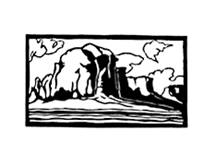
Monument Valley by Everett Ruess
From February to December 1931, Everett would travel on foot hundreds of miles in Arizona and Utah, visiting ruins, exploring the canyons and soaking in the natural beauty of the arid lands. From Monument Valley, he visited Canyon de Chelly, and than returned to Flagstaff to recuperate at a new friend’s ranch on San Francisco Peak, before finding a short-lived job marking lambs at a sheep camp. With his meager coffers refueled from this temporary job, Everett went north to explore the Grand Canyon, before heading to Zion National Park and a serious bout of poison oak.
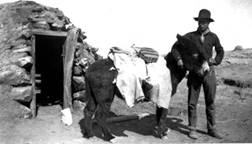
Everett Ruess, burro and hogan
In letters, Everett continues to describe his travels and money problems, but occasionally he indulges in lyrical descriptions of the landscape. In a letter to Bill Jacobs, he begins to explore his gift for prose, writing, “Then the treeless western hills were rimmed with orange that faded to green and deep blue. A cold clear breeze caressed me and the full moon rolled through clouds. The lunatic quaver of coyote-silence and sleep.”
It was also on this trip he begins to develop his philosophy of living life to the fullest, traveling, drawing, painting and writing at the expense of loneliness and hardship. He acknowledges this loneliness; “My friends have been few because I am a freakish person and few share my interests. My solitary tramps have been made alone because I couldn’t find anyone congenial-you know its better to go alone than with a person one wearies of soon.” In order to help battle loneliness, Everett adopts a little Navajo dog that he names Curly.
Youthful uncertainty occasionally haunted Everett, forcing him to examine the level of his artistic skills. In a letter, he observes; “I have met several well known artists and got a new slant on the matter with my stuff. It is improving. That criticism of your friend about comparative distance was well founded, but I am getting over that obstruction. I am confident that I can make something of my work-the problem is how to keep alive until I have succeeded in a larger measure.” This is also a period when Everett learns hard lessons about the difficulties of travelling. He wears out his first burro,
replacing it with an even older specimen that also gives out leaving Everett stranded in Northern Arizona.
With winter, approaching Everett and Curly catch a ride to central Arizona, ending up in Superior where he purchases two new burros despite his mother’s concern that two were an extravagance. On October 23, Everett embarks on a trip north along what he calls the Apache Trail ending up at the Tonto National Monument where he spends time exploring cliff dwellings. In his continual search for funds to keep traveling, Everett earns money by packing hunters into the wilderness and entertains the idea of guarding a bootlegger’s still. Work is scarce and the weather cold and by late December 1931 he has found pasture for his burros and hitchhiked home to Southern California.
1932
After two months with his family, Everett returned to Arizona in March 1932 with two friends, Bill Jacobs and Clark (last name unknown). Together the three explored central Arizona but by May, Bill and Clark had returned to California after convincing Everett to trade his burros for two horses. In 1932, Everett begins to keep a journal from which we learn that the split that sent Bill and Clark back to California was bitter. Bill and Everett would continue to correspond, but Clark disappears from Everett’s life.
On March 30, Everett writes to his family from Roosevelt in the Salt River Valley, asking for money and books. He writes again from Roosevelt on April 30, but then disappears until June when he writes Bill from the now abandoned town of Zeniff in Northern Arizona. In this letter he describes traveling north through the Sierra Anchas, up over the Mogollon Rim and finally into the high desert south of Holbrooke. He tells Bill that, “I saw plenty of pine trees when I was way high up in the Mogollons but I was glad when I left them behind. I like the aspens and the pale, waxy yellow green of the oaks.” His trip north was rugged and he describes stepping on rattlesnakes, losing his dog Curly and eating nothing but “parched corn and jerky.” During this trip, he works on a cattle ranch, swapped his horses for burros and then replaced those burros with a white cow horse named Nuflo and a tough old bay, named Jonathan. All this adventure brought him back to the landscape imbedded in his heart, Everett writes, “Once more I am in the desert I know and love-red sand, twisted cedars, turquoise skies, distant mesas, and, far to the south, the blue line of the Mogollan Rim.”
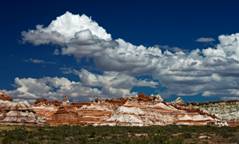
Moenkopi Wash, Hopi Reservation (Dana Thomas)
Everett attended a rodeo in Holbrooke, before walking north into the Navajo Reservation, traveling and working his way through Ganado, Chinle, Canyon de Chelly and Canyon del Muerto and finally up into the Lukachukai Mountains on the New Mexico border.
His journal suggests that Everett was wrestling with the demands of keeping himself and his horses fed while dealing with the bitter split from his California friends. In northeastern Arizona, we begin to see his appreciation for the beautiful landscape re-emerge. A letter to Waldo contains, “The night before last, near the lake, I made a camp by moonlight. Inky clouds swept across the sky, wild winds whiffed by. Lightning flashed and thunder muttered ominously.” While in a journal entry from Canyon de Chelly he writes, “God how the wild calls to me. There can be no other life for me but that of the lone wilderness wanderer.” What has started as a season with Everett, hoping to share his experiences with friends, had evolved into a time of melancholy loneliness and self-reflection interspersed with wild joy.
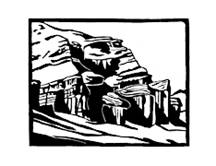
Canyon de Chelly by Everett Ruess
Despite the death of his horse, Jonathan, in Canyon de la Muerta, the time spent in the canyons and the Lukachukai Mountains, seemed to have put Everett into a more serene frame of mind. Travelling to Mesa Verde, he stays with the park rangers, explores the famous ruins and turns his remaining tired horse, Nuflo, out to pasture, before beginning to hitchhike for home in late August. After a stop in the Grand Canyon followed by a long haul across the Mojave Desert, Everett arrived in Southern California in September of
1932.
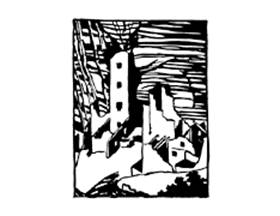
Mesa Verde by Everett Ruess
During the autumn of 1932 and early winter of 1933, perhaps to please his father, Everett attended UCLA. He did not pursue his studies with enthusiasm, but rather seemed to go through the motions earning D’s in all his courses with the exception of geology and English. Instead of enrolling for another semester, Everett began to plan a trip to the Sierra Nevada for the spring and summer of 1933.
1933
On May 27, 1933, Waldo drove Everett up over the Grapevine, north through the San Joaquin Valley and then east up the Kaweah River. In Three Rivers, Everett purchased two burros, Betsy and Grandma, and started up the Marble Fork of the Kaweah River with a plan to follow the Sierra Nevada north through Sequoia and Kings Canyon and then into Yosemite.
His 1933 journal tells of a more mature Everett, better able to handle the rigors of travel, but also dealing with moodiness that some have attributed to the first signs of depression and bi-polar disorder. In a letter to his family he writes, “My health and complexion have greatly improved, and every once in a while I feel ecstatic, but I slip out of such moods quite easily.” Adding to the depression speculation, he responds sarcastically to a question from his mother, “No, I am in no danger of a nervous breakdown at present. How about you?”
A reading of his journals from this period gives a glimpse of Everett struggling through deep snow, fishing, meeting fellow travelers, reading, drawing and painting. It is also during this trip that he continues to develop his prose in his letters home, writing on August 30 from Castle Crags, “Beauty and peace have been with me, where I have gone. At night I watched pale granite towers in the dim starlight, aspiring to the powdered sky, tremulous and dreamlike, fantastical in the melting darkness.”
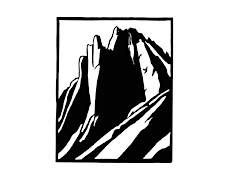
Granite Towers by Everett Ruess
His natural inclination to travel slowly, coupled with deep snow delayed his arrival in Yosemite until early October. With cold weather approaching, Everett spent a couple of weeks touring Yosemite Valley, before selling his burros and hitching a ride into the San Joaquin Valley. From Merced, he rode the rails to Oakland and then crossed the Bay into San Francisco.
Everett’s choice of San Francisco as a place to sit out the cold months, illustrates a growing desire to follow his own path, to grow as an artist and expose himself to intellectual stimulation. His time in San Francisco consisted of visiting museums, attending lectures, plays and musical performances. Repeating his approach to Edward Weston in Carmel during 1930, Everett searches out and meets painter Maynard Dixon and his wife, photographer Dorthea Lange. Dixon was an influential painter of the southwest who maintained a home near Zion National Park. Dorthea, well known locally, had not yet achieved national attention for her photographs of the impact of the Depression on farm families.
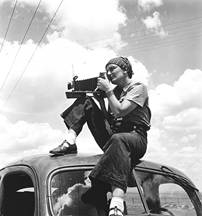
Dorthea Lange

Maynard Dixon
Everett spent time with both Dixon and Lange, but it was Dorthea, who took Everett under her wing, taking him to exhibits and museums. Everett also posed for a series of portraits by Lange with his large black cowboy hat. These photographs must have pleased Everett greatly, by capturing the rugged image he held of himself.
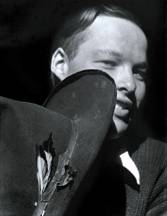
Everett Ruess by Dorthea Lange
Living in San Francisco surrounded by working artists, Everett began to realize that his talent was undeveloped and that to refine his artistic gifts would take considerable time and effort. He explains his frustration in a letter to his brother, “I thought I might be able to loosen up and really do a quantity of good work, because I was able to see some very splendid things; but I have not been able to loosen up for some time.”
The time Everett spent in the bay area allowed him to indulge his love of music. He writes of attending symphonies with friends, including the Dixons. In most cases, Everett was a guest at the symphonies, as he continued to struggle to earn money. In a December 22, letter to his brother, Everett apologizes for not sending a Christmas gift and then confesses; “I have been spending what is, for me a good deal of money lately. I sold a couple of pictures today, and spent the money already. Half the time I am broke or without money for carfare and telephone.”
San Francisco was also time when Everett met Francis, a girl who he describes as “one girl with whom I am intimate,” thus putting a kink in the theory that Everett’s obsessive traveling was in response to uncertainty about his sexuality.
In early January, Everett, answering his family’s concern that his lifestyle and wandering is putting his future at risk, writes,”As for me, I have tasted your cake, and I prefer your unbuttered bread. I don’t wish to withdraw from life to college, and I have a notion, conceited or not, that I know what I want from life, and can act upon it.” Everett spends the rest of January and February 1934 in and around San Francisco, finally returning to the family home in March to prepare for another summer in the arid southwest.
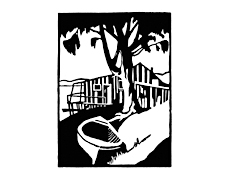
Tomales Bay by Everett Ruess
1934
Everett coerced a reluctant Waldo to drive him to Kayenta, Arizona in mid-April of 1934 to begin a season of wandering. In Kayenta, Everett repeated the same search for transportation that he had indulged in over the last three years. His choices were two burros he named Leopard and Cockleburrs. Leading the burros, he began a long stretch of traveling through northeastern Arizona, visiting old haunts in Monument Valley and the Lukachukai Mountains. In 1934, we only have Everett’s letters to tell his story. We can assume that he kept a journal, but it disappeared with Everett when he walked into the Escalante Wilderness for the last time.
Everett’s letters portray a more confident traveler and hint at improving finances as he begins to sell a greater volume of artwork. The letters also paint a picture of a more fatalistic and reckless Everett, willing to risk death and injury in pursuit of his chosen lifestyle. In a May letter to his friend Edward Gardner he writes, “One way and another, I have been flirting pretty heavily with Death, the old clown.”
In 1934, Everett’s writing, suggests that he is changing, becoming more entrenched in his solitary lifestyle. In one of his last letters, he tells Waldo, “I don’t think I can settle down. I have known too much of the depths of life already, and I would prefer anything to an anticlimax. That is one reason I do not wish return to the cities.”
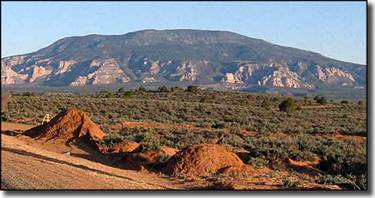
Navajo Mountain, Utah
In mid-June, Everett ventures into the rugged canyon country in southern Utah, climbing sacred Navajo Mountain, camping at War God Springs and visiting Rainbow Bridge. This is truly difficult country requiring an experienced traveler with the ability to endure hardship. The harshness of the terrain is evidenced by the fact that the explorers who built the first trail to Rainbow Bridge enlisted dynamite to breach vertical rock fins that blocked their path. Everett writes from War God Spring, “The beauty of this place is perfect of its kind; I could ask for nothing more. A little spring trickles down through aspen and white fir. By day, the marshy hollow is as warm with gorgeous butterflies: Tiger and Zebra Swallowtails, the Angel Wings, the Mourning Cloak and others. There are hundred delightful places to sit and dream; friendly rocks to lean against—springy beds of pine needles to lie on and look up at the sky.” In the same letter he confides, “The beauty of this country is becoming part of me. I feel detached from life and somehow gentler.”
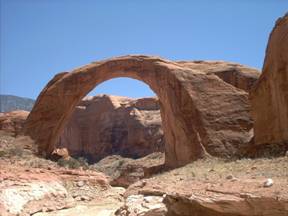
Rainbow Bridge, Utah
Returning to Kayenta, Everett meets the members of a University of California archeological expedition in route to Tsegi Canyon to excavate Anasazi ruins. Craving companionship and perhaps, hoping for a paying job, Everett followed the group. Showing up unannounced at their camp, he took an unpaid position as a cook in a group that split off to explore a site in a cave high up on the canyon wall. It is rare to get a glimpse of Everett through someone else’s eyes, so it is interesting to read the thoughts of Clay Lockhart one of the archeologists who befriended Everett. Lockhart observed that Everett was nonchalant about his safety, climbing the cliffs looking for an always better vantage point to draw or paint.
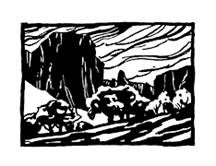
Tsegi Canyon by Everett Ruess
Parting company with the archeologists at the end of their dig, Everett traveled south to the Hopi Reservation with the goal of observing ritual Hopi Dances. He attended a Snake Dance at Hotevilla, and continued on to Mishongnovi where he received the rare honor of participating in the Antelope Dance.

Hopi Snake Dance
In 1931 and 1932, Everett’s letters about the Navajos and Hopis suggest that he was not entirely comfortable with the Arizona tribes. In 1934, we begin to see a different attitude emerge. In a letter to Frances, he says, “The Indians have many vices, but they are kindly people, and I like them and admire their fine qualities.” He also notes, “There are some handsome, lithe young girls among the Navajos here.” Everett demonstrates his increased comfort level with the Native Americans by making a conscience effort to expand his knowledge of the Navajo language.
After his sojourn with the Hopi, Everett replaces the burro Leopard with the bigger Choclatero, travels to the Grand Canyon and imposes upon Clay Lockhart’s hospitality in Flagstaff before visiting Oak Creek Canyon. Travelling north, he returns to the Grand Canyon, crosses the Colorado River at the Navajo Bridge, walks across the Pariah Plateau and into Utah to visit Bryce Canyon. His letters in 1934 lost much of the chatty quality of the past and increasingly contained more of his romantic descriptions of the landscape. Everett described a sunset,”The saffron of the clouds that lie low on the skyline is turning to a soft blue-grey. The orange turrets and pyramids opposite me fairly glow against the paling sky.” Traveling east from Bryce, Everett arrives in Escalante, Utah in early November, where he camps under the cottonwoods, takes in a movie, flirts with local girls and plans his exploration of the rugged canyon country of what is today the Grand Staircase-Escalante National Monument.
On November 11, Everett packed and led his burros into the rugged red rock canyons of southern Utah. Fifty miles from Escalante, he met and spent two nights with the sheepherders, Clayton Porter and Addlin Lay near Soda Gulch. On the morning of November 21, Everett said goodbye and headed east telling the shepherds of his desire to paint and draw around Hole-in-the-Wall, where Mormon pioneers famously carved a passage through solid rock on their way to settling southeastern Utah. Porter and Lay were the last people to admit to seeing Everett alive. When he left their camp, Everett Ruess dropped off the face of the earth, leaving behind one of the most persistent mysteries of the desert southwest.
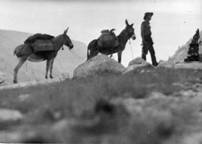
Everett Ruess
The Search
It was not surprising for Everett to be out of touch for an extended period and he had written his parents from Escalante that there would be no letters from him for two months, but after three months Christopher and Stella began to worry. Their concern turned to alarm when they received Everett’s unopened mail from the post office at Marble Canyon, Arizona. On February 7, 1935, they wrote to Escalante’s Post Mistress Mildred Allen, asking if Everett had returned from the backcountry. Mrs. Allen passed the letter to her husband Jennings Allen, a County Commissioner, who began to make inquiries around Escalante. Unable to find anyone who had seen Everett after he left Porter and Lay on November 21, Allen wrote a return letter to the Ruess Family and organized a search party.
This first rescue party left Escalante on March 1 and began to search the country to the east of the sheepherder’s camp. They examined the country along the main trail and explored the deep gulches that Everett would have passed on his way to Hole-in-the Wall. Soda and Willow Gulches showed no sign of Everett, but in Davis Gulch, the searchers found Everett’s burros, safe and healthy in a makeshift corral.
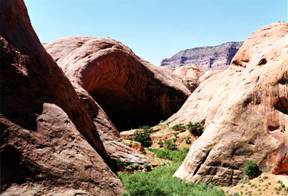
Davis Gulch, Utah
Davis Gulch was a secluded canyon with an active creek that wound three miles north and downstream from where Everett’s burros were discovered to its confluence with the Escalante River. South or upstream from Everett’s jury-rigged corral, Davis Gulch continues for a few miles ending in a impassable rock pour-over making the Gulch a long box canyon carved out of slick rock. After finding the burros, the party split, a portion taking the burros back to Escalante and the remainder working downstream looking for Everett or clues to his fate. As the searchers descended, they explored the ruins that are common throughout the Escalante region. In a small cliff dwelling near the top of the canyon wall, the searchers found a cryptic inscription. Someone had carved into the rock below the ruin’s doorway NEMO 1934. Near the carving, four Anasazi pottery jugs had been lined up on a flat rock.
On March 3, Allen had wired Christopher and Stella about the departure of the search party and on March 8, he wrote them describing the discovery of the burros and the NEMO carving, adding that the party had found, “his tracks where he had been traveling back and forth.” Allen observed that members of the search party believed that Everett had left Davis Gulch by a trail that climbed onto the Kaiparowits Plateau near his makeshift corral. In addition, to his tracks, the burros and the mysterious carving, an abandoned camp of Everett’s was found. The camp contained trash from his meals and marks in the dirt indicating where he laid his bedroll. The search party did not find the rest of his camp outfit that would have included; food, cooking gear, bedroll, journals, letters, art gear, valuable Navajo blankets and books. After a search of the Kaiparowits Plateau without finding any additional clues, the party returned to Escalante. After this first search, most of the party believed that Everett had died an accidental death. On March 15, Allen wrote to the Ruess’, “We have searched the country good on this side of the Colorado River, and haven’t been able to find any fresh sign of Everett.”
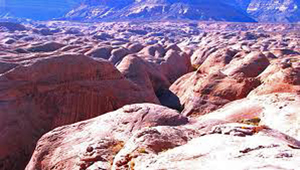
Davis Gulch
Still trying to find Everett, Allen led a second search party that spent the end of March and first part of April 1935 searching the rock plateau to the south of Davis Gulch, an area left untouched by the first group of rescuers. After this effort, Jennings Allen wrote to Everett’s family “Everett must (have) left this section and gone to the Navajo Reservation; he can’t be anywhere on this side of the Colorado River alive because every inch has been searched.” Why Allen thought Everett might have crossed the Colorado and gone south into Navajo Country is not known, but perhaps he was just trying to provide a glimmer of hope for Christopher and Stella.
Two haunting questions emerged from these first two attempts to find Everett. The first question concerns his gear and personal possessions. If Everett died in an accident, where was his gear and why has it never been found?
The second question revolves around the inscription NEMO 1934. Everett’s parents initially believed that the reference was to the version of the “Odyssey” preferred by Everett and translated by Lawrence of Arabia. In this version the Latin word, “nemo” translates to the English “nobody.” Coupled with Everett’s reluctance to sign his own name in public suggests that NEMO 1934 was a form of sophisticated graffiti. Christopher later came to consider a more ominous interpretation. He entertained the idea that the inscription actually referred to “Twenty Thousand Leagues under the Sea” by Jules Verne. In Verne’s novel, Captain Nemo disappears intentionally to escape from civilization. The proper interpretation of Everett’s last known words remains open to interpretation.
Jennings Allen continued to hold out hope of finding either Everett or solving the mystery of his disappearance. He traveled to Salt Lake City with the goal of convincing the governor or the Desert News to underwrite an additional rescue effort. When those attempts failed, he persuaded the Associated Civic Clubs of Southern Utah to raise the funds to prolong the search. Rallying to the slogan that “no one gets lost in southern Utah” civic-minded citizens raised the money to put another search team in the field. This team left town on June 1, 1935, and stayed out for eleven days, before returning to town for the hay harvest. The search found additional signs of Everett in Davis gulch, including more footprints and a new NEMO inscription, but in the end added nothing to a better understanding of his fate. Out of the total lack of new evidence about Everett’s disappearance, a theory was born that Everett had corralled his burros and joined a group of Navajo’s traveling the trail from Escalante back to the Reservation.
The possibility that Everett had disappeared into Navajo Country fueled the strangest of the Everett Ruess searches. This search revolved around a drifter named Neal Johnson. Johnson, at best, an opportunistic hustler, at worst a con man wrote to Christopher Ruess in February 1935 and then made a surprise visit to Everett’s parents with the offer to take up the search. Christopher was naturally skeptical and was warned about Johnson by Jennings Allen, but out of desperation, he agreed to send Johnson money for the search.
Neal Johnson believed that Everett had crossed the Colorado at low water in late 1934 and was alive south of the river in Navajo Territory. This assumption led him to hire or claim to hire Navajo trackers to look for signs of Everett. Like all good con artists, Johnson kept Everett’s parents on the hook, writing over seventeen letters to them from March to August 1935. These letters, postmarked from all over the southwest, some from places such as Dove Creek, Colorado or Moab, Utah that were nowhere near the Navajo Reservation. The common denominator of these letters, were Johnson’s requests for money to continue the search for Everett.
The final chapter of Neal Johnson’s portion of Everett’s story is the agreement he reached with the Salt Lake Tribune to publish a series of articles about the hunt for Everett. To this end, the Tribune sent reporter, John Upton Terrell to write daily stories about the search. Starting in eastern Utah at Blanding, Johnson and Terrell moved south into Monument Valley to Kayenta. The search developed into a series of interviews with people who had known or encountered Everett. Aiding and abetting Johnson and Terrell was a “well-know tracker” named Dougeye who led them around the Navajo Reservation, but more importantly claimed to have been on the Escalante Trail at the time of Everett’s disappearance. Dougeye reported that no evidence existed that Ruess had ever crossed the Colorado. This conclusion was supported by Terrell’s interviews with Navajos who pointed out that the tribe was a close-knit community and Everett’s presence on the Reservation would have been known and broadcast throughout the clans.
In order to meet the searchers and better understand their son’s fascination with the desert southwest, Stella and Christopher traveled to Arizona and Utah in June 1935, visiting many of Everett’s haunts and meeting his friends and acquaintances. After this trip, Everett’s parents, although not convinced of his death, concluded that he would not return in the immediate future.
The final concrete evidence about Everett’s disappearance was a discovery made by an archeology team chronicling Anasazi sites 23 years later in 1957, prior to the filling of Lake Powell. In Cottonwood Canyon, a side canyon of the Colorado, southwest of Hole-in-the-Wall, they came upon camp equipment including silverware, pots and a canteen. In addition, they found a box of razor blades carrying the logo of the Owl Drug Company in Los Angeles. The equipment was turned over to the County Sheriff, who in a testimony to the enduring quality of Everett’s story sent them to Stella, who doubted that they belonged to her son. Like the lower reaches of Davis Gulch and much of the territory where Everett disappeared, the waters of Lake Powell, now cover the Cottonwood Canyon campsite.
The Theories
Over the years, many theories have been advanced to explain Everett’s disappearance in 1934. Some of these theories have logic to back them up, others are based upon wishful thinking and still others rely on Elvis type sightings of Everett alive and well in unlikely locales.
Everett took many chances as he negotiated his way around and over cliffs in search of the best vantage point from which to paint or gaze out over the scenery. In 1934, Clay Lockhart the archeologist who befriended Everett during the dig in Tsegi Canyon observed that Everett climbed the cliffs with little thought of his own safety. Everett, himself wrote that he was careless during his travels, including the comment that he had been “flirting heavily with Death, the old clown.” Everett could have died an accidental death in the canyon country without his body being discovered. A fall or a confrontation with a mountain lion are both believable scenarios. Arguing against the accidental death theory is the fact that if Everett had been a victim of an accident, his missing camp equipment, journal, letters and painting supplies would have been found at a camp near his burros. Those who support this theory suggest that a passerby or a member of the first search party organized by Jennings Allen stole the valuable supplies.
A convincing argument suggests that Everett was the victim of foul play. This theory comes in two forms. The first is that cattle rustlers killed Everett and the second is that an outlaw Navajo committed the dirty deed.
Cattle rustling was a fact around Escalante in the 1930’s. Usually, a small-scale operation, rustling was often a matter of locals stealing from their neighbors. It is possible that Everett, stumbled upon a rustling operation, was murdered and his outfit stolen. Rustlers would have been reluctant to steal his easy to identify burros. Adding credence to this theory is the fact that the law-biding citizens of Escalante, frustrated with increased rustling had started a rumor that they were employing an agent to bring the rustlers to justice. Everett, although harmless in appearance, was a stranger in the Escalante Wilderness and might have been a victim of mistaken identity. Giving further validity to this theory is the fact that evidence points toward one notorious rustler, Keith Riddle, who while drinking heavily, claimed responsibility for Everett’s death. Those who believe in both the accidental death and murder by rustler theories are convinced that there exists a cache of Everett’s journals, letters and artwork in an attic somewhere in or near Escalante stashed away by a thief or killer hiding their handiwork.
The second foul play theory revolves around Everett’s death coming at the hands of a Navajo. This was the conclusion reached by the reporter John Upton Terrell who concluded at the end of his series of articles, writing, “Everett was murdered in the vicinity of Davis Canyon. His outfit was stolen. He never reached the Colorado River.” Navajos regularly traveled the trail north from their reservation to Escalante and it is possible that Everett naively invited the killer into his camp. Suspicion has fallen on a Navajo named Jack Crank who served time in the penitentiary. Crank had several possible motives for killing Everett, including; theft of his equipment, the ritual need for a scalp from a blood enemy and his hatred of white men. The counter argument to this theory is that the initial searchers, while finding Indian footprints on the main Escalante Trail, failed to find sign of Navajos in Davis Gulch.
A reading of Everett’s journals and letters suggest a young man who was wrestling with depression and perhaps, as witnessed by his extreme mood swings, bipolar disorder. This coupled with an ominous interpretation of the NEMO engraving has led to speculation that Everett engineered his own disappearance, either to disappear into another life or to commit suicide. The strongest argument for this theory is Everett’s own writing where he exhibits his ability to reach extreme highs of emotions and then fall into deep despair. The quote most commonly used to support this theory is, “I intend to do everything possible to broaden my experiences and allow myself to reach the fullest development. Then, and before physical deterioration obtrudes, I shall go on some last wilderness trip, to a place I have known and loved. I shall not return.” In addition, Alec Anderson, a friend who spent time with Everett in Los Angeles, reported Everett’s parting words as, “And I don’t think you will ever see me again, for I intend to disappear.” Ironically, the best argument against Everett arranging his own disappearance is the existence of those same letters. It seems highly unlikely that Everett, who wrote so many letters to family and friends, many, which speak about the future and his desire to pursue his art would choose either to end his own life or willingly cut all ties to establish a new identity.
If Everett did engineer his own disappearance and assumed a new identity, where did he go? This question has been answered in many different ways. Neal Johnson, the con artist, recorded a questionable sighting of Everett in Phoenix. In 1937, a woman claimed to encounter Everett near Monterrey, Mexico. She reported a conversation with a man who told her of living with American Indians, studying art in Chicago and making his living painting watercolors. Finally, in the late 1930’s, a couple reported seeing a man resembling Everett in the desert around Moab, Utah. When they approached him, the man was evasive and refused to answer questions.
The most common belief about Everett’s new life is that he disappeared into the welcoming and protective fold of the Navajo Nation to marry a Navajo girl. Many of the inhabitants of Escalante at the time of his disappearance believed that Everett had a Navajo girlfriend and Everett and written of “handsome, lithe” Navajo girls. It is also true, that over his years of traveling and living among the Navajos and Hopis he grew to admire their lifestyle. A photo of Everett has also added to this speculation. The photo shows Everett next to a Navajo woman holding a baby. Everett labeled this photo with the caption, “My Navajo Wife.” This romantic version of Everett’s disappearance has persisted despite the fact that it would have required that the entire Navajo and Hopi Nations, remain silent about Everett’s life among them. It would also mean that after his disappearance, Everett never again visited a trading post, or talked with a trader.
Almost eighty years after Everett left Escalante the mystery surrounding his disappearance remains. Christopher Ruess died in 1954, followed by Stella in 1964. Neal Johnson, the con man searcher was himself murdered. The inhabitants of Escalante and the Navajo Reservation have grown old and died. The sightings have stopped, but occasionally a clue appears. In the 1970’s a Lake Powell boater discovered a skeleton at the base of a cliff near Davis Gulch. He turned the bones over to a ranger for identification, but the bones were mysteriously lost.
In 2007, a body was discovered in a grave near Comb Ridge, fueling speculation that Everett’s disappearance had been solved. With the intervention of National Geographic Editor David Roberts, a facial reconstruction and DNA tests were performed. Both tests were positive, the bones were sent to the Ruess family and the Everett Ruess mystery was officially put to rest. Or was it? As with all things surrounding Everett Ruess, nothing is clear-cut. Those who had followed the course of events had difficulty understanding how Everett’s body could have made its way to Comb Ridge. A second DNA test was performed and the body was found to be that of a Navajo and in 2009, the bones were returned to the reservation for burial.
Comb Ridge, Arizona
Everett Ruess has inspired books and articles, a movie has been made, a song has been written and countless independent searches have been performed. David Roberts, the National Geographic Editor has conducted his own search. Author, Mark Taylor used his search for Everett as a mechanism to confront his own demons. All over the southwest, prospectors, climbers, hikers, river guides and other desert rats are turning corners in isolated canyons wondering if they will be the one to stumble upon the clue that solves the mystery.
If the day comes when Everett’s skeleton is found at the bottom of a cliff or a weathered journal is uncovered in an Escalante attic, will the discovery be met with happiness? I am sure that some Everett aficionados will exult in putting the mystery to rest. I am equally sure that others will feel disappointment. For many of us the mystery of Everett Ruess disappearance a mystery that should remain unsolved. We will never know if Everett would have evolved into a great writer or painter or whether his solitary search for beauty w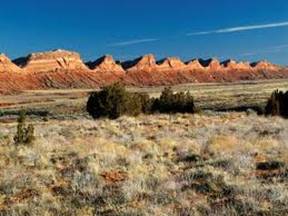 ould have made a lasting impact on the culture of the southwest. Without the knowledge of what he would have become, all that is left is a few letters, wood block prints, poems, journal entries and the mystery. Without the mystery, we are afraid that Everett would cease to haunt the deserts and canyons of the southwest. If that day ever comes, he will be missed. ould have made a lasting impact on the culture of the southwest. Without the knowledge of what he would have become, all that is left is a few letters, wood block prints, poems, journal entries and the mystery. Without the mystery, we are afraid that Everett would cease to haunt the deserts and canyons of the southwest. If that day ever comes, he will be missed.
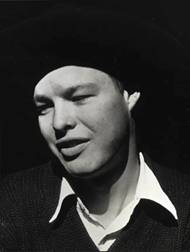
Sources
- “On Desert Trails with Everett Ruess” edited by Gary James Bergera
- “Everett Ruess, A Vagabond for Beauty & Wilderness Journey” edited by W. L. Rusho
- “The Mystery of Everett Ruess” by W.L. Rusho
- “Sandstone Sunsets” by Mark Taylor
- “The Mystery of Everett Ruess” – National Geographic Adventure Magazine, April/May 2009 by David Roberts
|